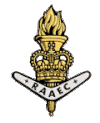Royal Australian Army Educational Corps
The Royal Australian Army Educational Corps (RAAEC) is a specialist corps within the Australian Army. Formed in 1949, the corps had its genesis in other services that existed within the Australian forces during World War I and World War II. It is currently made up entirely of commissioned officers and is responsible for the provision of education-related services within the Army. Its various roles include instruction, designing computer-based learning materials, instructional systems, language training, literacy, and numeracy.
| Royal Australian Army Educational Corps | |
|---|---|
 Corps badge of the RAAEC | |
| Active | 1949–present |
| Country | Australia |
| Branch | Australian Army |
| Type | Military education |
| Commanders | |
| Current commander | Colonel Anita Rynne |
| Colonel-in-Chief | The Duchess of Gloucester |
History
The RAAEC was established in September 1949 as the Australian Army Educational Corps and was granted Royal assent in 1960.[1] Consisting of the Crown and a boomerang upon which the corps' initials are inscribed superimposed over a "fluted flambeau of flames", the current RAAEC corps badge was adopted in 1964.[2] It is the only corps badge in the Australian Army where the crown does not appear at the top and is based on the badge devised for the Royal Army Educational Corps by King George VI in 1949.[3]
The corps grew out of the Australian Army Education Service (AAES), which was established on 29 October 1943 during World War II,[1] under the command of Colonel Robert Madgwick.[4] Through the AAES, the corps draws its lineage from the Australian Army Education Scheme, which was established under Madgwick on 5 March 1941.[5] That scheme itself was based loosely upon a vocational education scheme that had been established during World War I within the Australian Imperial Force in 1918 under George Merrick Long, as part of the demobilisation and repatriation process.[5]

Throughout its history, the corps has deployed members to support Australian forces deployed on operations. Initially, they deployed to Japan as part of the British Commonwealth Occupation Force, where they provided education support for service personnel and their children.[6] Later, members of the corps were sent to Korea during the Korean War, where they were attached at battalion level to provide soldiers with training in the field. During the Vietnam War, RAAEC personnel were deployed to support the 1st Australian Task Force at Nui Dat.[1][7]
Throughout its history, the corps has also provided short and long-term courses to enlisted soldiers. Short-term courses have been developed internally by education staff, while some long-term courses were accredited with external authorities. In Australia during the 1960s and 1970s, many education courses were provided to soldiers as aq requirement for promotion to a higher rank. At the same time, In the (former) Territory of Papua New Guinea, Australian National Servicemen in the education corps provided courses in literacy, numeracy, and citizenship to non-commissioned ranks at various army barracks.[8]
Current role and structure
The RAAEC is responsible for many educational areas of military training, including the development and implementation of technology and communications training at the Royal Military College, Duntroon and the Australian Defence Force Academy, managing and conducting long-distance education, teaching English to foreign students, analysing education proposals, developing training, and delivering literacy and numeracy and "train the trainer" programs to non-commissioned officers (NCOs) on promotion courses.[1]
Currently, the corps is made up entirely of commissioned officers in the specialist service officer/professionally qualified stream,[9] although in the past the RAAEC has had some NCOs allocated to it. The majority of the corps' personnel are civil qualified teachers; however, additional information technology specialists have been laterally recruited to manage the computer-based learning packages within the Army Learning Production Centre.[9]
Members of the RAAEC are posted to a number of locations including:
- Headquarters Forces Command – Army: Sydney;
- Army Learning Production Centre (ALPC): Sydney, Brisbane, Albury/Wodonga;
- Defence International Training Centre (DITC): Laverton, Victoria;
- Various major training establishments in Victoria, New South Wales, Canberra and Queensland;
- Individual training centres, located in every state;
- Some overseas locations, including positions as language advisors.[9]
The current Colonel-in-Chief of the RAAEC is The Duchess of Gloucester.[10] The current Head of the Corps is Colonel Anita Rynne.
Notes
- Dennis et al 1995, p. 513.
- Jobson 2009, p. 140.
- Anonymous (Spring 1987). "The RAAEC Corps Badge". Torch. 21 (1).
- Spaull, Andrew (2000). "Madgwick, Sir Robert Bowden (1905–1979)". Australian Dictionary of Biography. National Centre of Biography, Australian National University. ISSN 1833-7538. Retrieved 1 February 2011.
- Long 1963, p. 84.
- Directorate of Army Education 1990, p. 99.
- Directorate of Army Education 1990, p. 121.
- The role of conscripted education corps staff in Papua New Guinea has been published in Chalkies: Conscript Teachers in PNG (National Library of Australia ID 3084181) Armi Wantoks (National Library of Australia ID 3377828) and at www.NashosPNG.com
- "Education Officer". Department of Defence. Retrieved 1 February 2011.
- "The Royal Family—HRH The Duke of Gloucester". Burke's Peerage. Retrieved 1 February 2011.
References
- Directorate of Army Education (1990). RAAEC Corps History. RAAEC Information Bulletin 2/90. Campbell, Australian Capital Territory: Australian Army.
- Dennis, Peter; Grey, Jeffrey; Morris, Ewan; Prior, Robin (1995). The Oxford Companion to Australian Military History. Melbourne: Oxford University Press. ISBN 0-19-553227-9.
- Jobson, Christopher (2009). Looking Forward, Looking Back: Customs and Traditions of the Australian Army. Wavell Heights, Queensland: Big Sky Publishing. ISBN 978-0-9803251-6-4.
- Long, Gavin (1963). The Final Campaigns. Australia in the War of 1939–1945, Series 1—Army. Volume VII (1st ed.). Canberra: Australian War Memorial. OCLC 1297619.